350 Search Results for aided language input
May 18, 2013
by Carole Zangari -
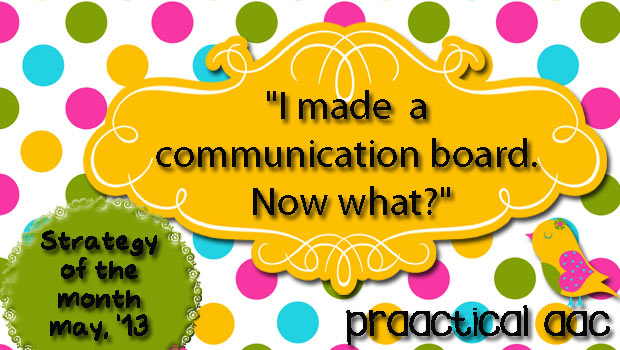
Earlier this month, we shared some ideas for making communication boards using color coding and also for creating boards geared to different communicative purposes. Making the communication board according to some basic principles is a good thing, of course, and it takes a decent amount of thought and planning. Even more important, though, is developing an intervention plan so that the augmentative communicator learns how to use the board effectively. Here are some of our thoughts on how to teach someone to use a new communication board. Model It We’ve talked about aided language input so many times that I’m almost embarrassed to mention it. Almost. The truth is, it is a ‘must do’ strategy when we’re first introducing a communication board, book, SGD, or AAC app. Incidental learning is important for just about all of the people with whom we work. It is never the only strategy we use,... [Read More...]
May 11, 2013
by Robin Parker -
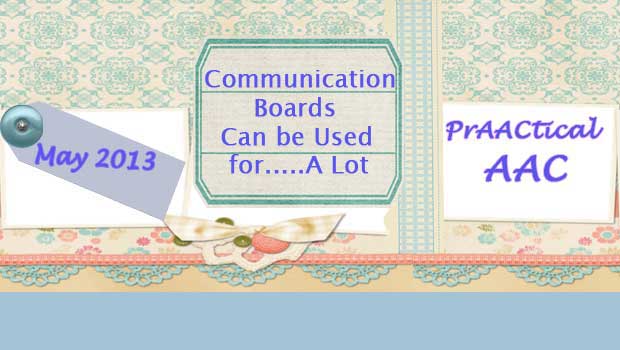
When we think of AAC and communication boards or displays, we often think of comprehensive core and fringe words. We think of a board that will represent the most possible communication functions, vocabulary, and generative language. However, there are many other ways to create and use communication boards. There are many other ways because there are many reasons we communicate and sometimes it is best to create a communication board that focuses on a specific communication need. AAC is not one thing but a system of communication supports, and for most AAC users, there should be a multitude of communication options that will aid in robust communication and language needs. All AAC users should have a comprehensive individual communication display whether low tech (communication book) or high-tech (AAC device or App). But…. many AAC users will also benefit from communication boards that support a specific communication purpose. The reason for... [Read More...]
April 27, 2013
by Robin Parker -
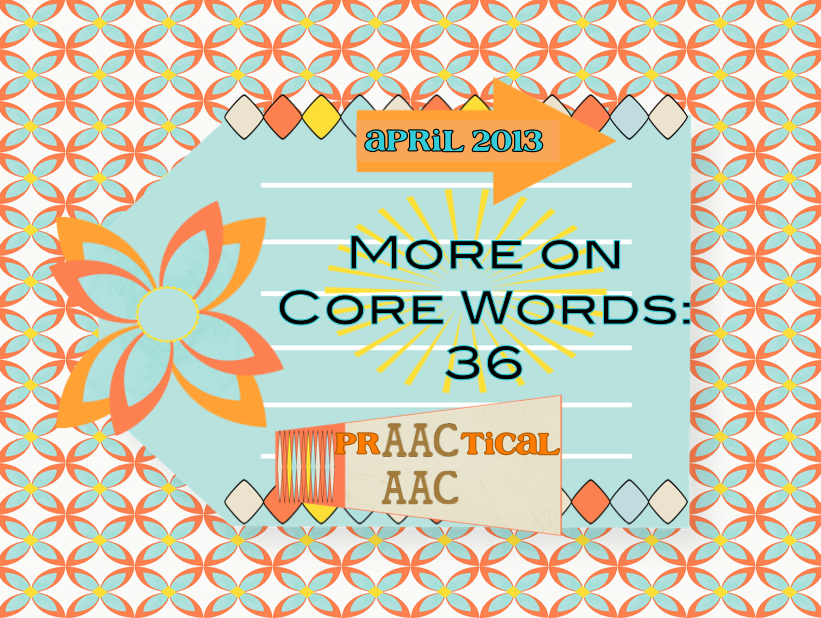
This month we have talked about core words and teaching strategies & considerations for facilitating USING core language. We have talked about aided language input, creating frequent opportunities, making connections b/w symbols and their referents, and motor planning/automaticity. As April ‘goes out’, we add graduated prompting/prompt hierarchies, and wait & signal/time delay prompts. The key to teaching AAC core word language is strategies…. Aided language input (ALI) is fairly simple to do but sometimes overlooked. However, once it becomes habit, it is hard not to do even when you are ‘just’ talking about AAC displays. There are many clinical rationales or reasons why ALI is so important. It provides a model of the language we expect from the child (or adult), and how would anyone speak a language if they never ‘heard’ it. ALI also helps by introducing new words and symbols in meaningful contexts. If we are speaking AAC throughout the day then... [Read More...]
April 25, 2013
by Carole Zangari -
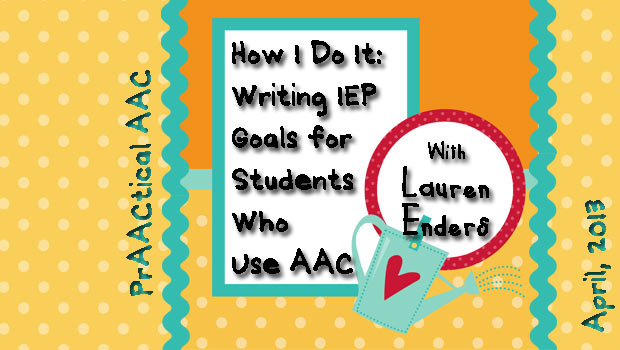
We’re so happy to welcome Lauren Enders back to share some more thoughts on AAC and the IEP. In her first post on this topic, Lauren addressed some frequently asked questions. Today, she provides a very valuable perspective on writing IEP goals for students who use or need AAC and some wonderful resources. Very often, I receive requests for support from teachers and speech therapists that are writing IEP goals for their students who use AAC. When we sit down to discuss their questions, the first thing I remind them is that AAC goals are no different from any other IEP goal. I recall a workshop I attended years ago presented by Gail VanTatenhove that helps put IEP goals for AAC into perspective. Gail said that AAC therapy is just language therapy. Isn’t that true? Aren’t we just teaching language? For this student, language is simply being expressed in a... [Read More...]
April 20, 2013
by Carole Zangari -
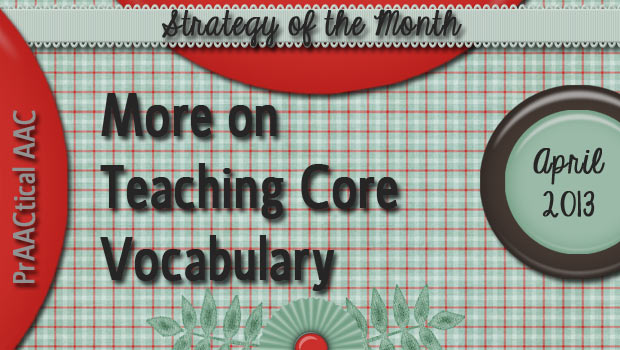
Last week, we talked about two key strategies for teaching core language: using aided language input and creating frequent opportunities to teach and elicit core words. In today’s post, we’ll expand the number of words and discuss two additional considerations for teaching core words. Aided language input is always important in working with beginning users of AAC. It exposes them to their new means of communication, provides them with a competent model of their AAC system, and introduces them to words and symbols they don’t yet know within a meaningful context. It also forces us to slow down when talking, something that can be very beneficial when you consider that many beginning users of AAC also have difficulty processing oral language. (It may take them longer to decode what they’re hearing and they may have to concentrate more than the average kid.) If you’ve actually tried pointing to symbols as... [Read More...]
April 13, 2013
by Robin Parker -
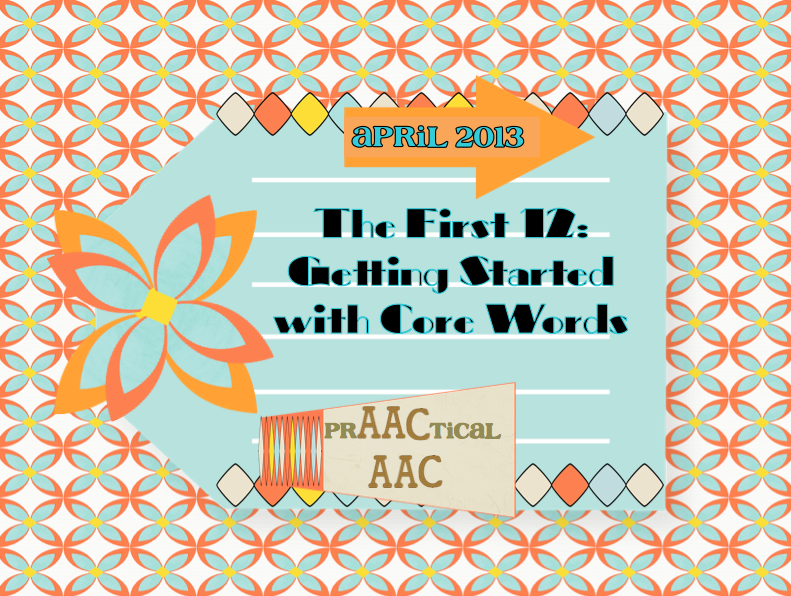
The focus this month is on core word vocabulary and effective teaching strategies. Most core vocabulary is represented through abstract symbols that range from translucent (i.e., makes sense after it is explained) to opaque (i.e., doesn’t have any resemblance to the word or concept) which makes the need for effective teaching all the more important. It also makes it more fun because meaningful language experiences, emotional language experiences, and repetition with variety experiences are going to be the platform for teaching. Within the platform of authentic language experiences, layers of teaching strategies can be applied. The more strategies we apply to learning, the more we assure ALL learners will benefit from our teaching. Core word vocabulary teaching begins with a few premises that underlie the process. These are not new ideas but ones that should be reaffirmed as you begin teaching. It is important, as always, to presume competence. All learners... [Read More...]
April 5, 2013
by Robin Parker -
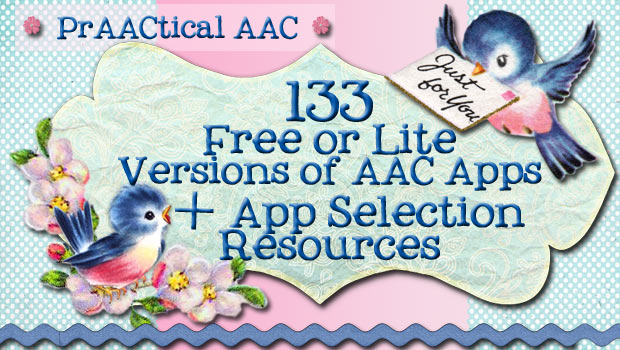
Here is our most recent update of free and lite versions of AAC apps for iOS and Android platform devices + a variety of resources related to AAC app selection. We strongly continue to advocate for a systematic process for AAC app selection. We recommend AAC app decision making in the context of a feature match process that gives appropriate attention to the full range of AAC options. Tools to Use In Making Decisions About AAC Apps Feature match form developed by Jessica Gosnell at Boston Children’s Hospital Feature match checklist created by Scott Marfilius and Kelly Fonner Our supplemental rubric covering language and communication features, RELAAACs Places to Go to Find AAC Apps and Reviews Comprehensive AAC app list for iPhone and iPad by Jane Farrall AAC Tech Connect’s Apps Assistant OCALI’s listing of apps for individuals with ASD Tech in Special Education Aidis Trust Communication App Reviews Training... [Read More...]
March 28, 2013
by Carole Zangari -
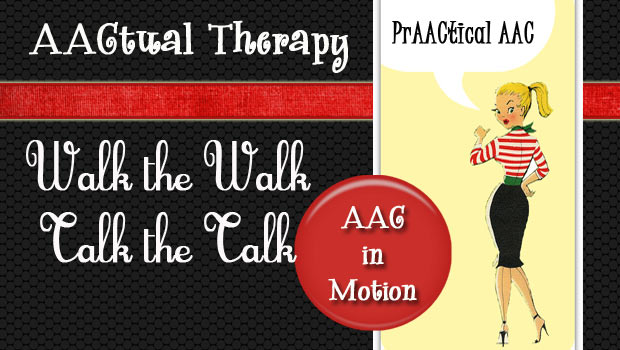
Tanna Neufeld hits another homerun with this post about co-treating children with multiple disabilities. Collaborating with our colleagues is both fun and challenging. Let’s take a look at the prAACtical ways that Tanna and her colleagues support kids with motor and visual impairments who are learning to use AAC. Fridays are my favorite. And not just for the obvious reasons (TGIF), but also because Fridays are one of the most challenging and exciting days of my work week. Every Friday, I am lucky enough to team with my favorite PTs for joint treatment sessions to support several children with multiple motor and communication challenges. Around our center, we lovingly refer to these kids as our “motor kids”. All of these little ones are nonverbal, and all have very complex motor challenges that significantly limit their ability to interact with traditional play and learning environments. Many of these kids also... [Read More...]
March 16, 2013
by Carole Zangari -
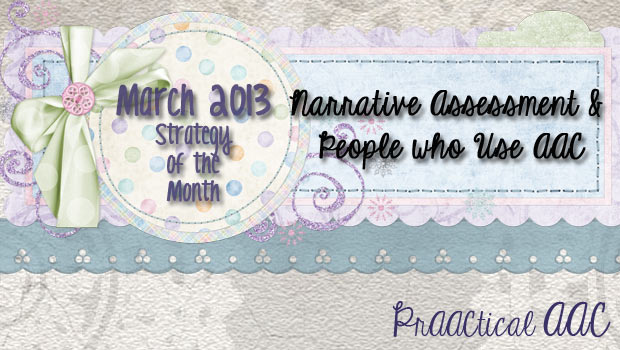
This month, we’ve been talking about building narrative skills in our AAC clients. We tried to build the case that including narrative language goals in our intervention allows us to help people who use AAC to participate more fully in social exchanges, relay more in-depth information, and achieve greater academic success. But how do we know where to start in narrative intervention? And how do we measure progress? In this post, we share some thoughts on the assessment of narrative language in AAC. Most test batteries that assess narrative language are designed to take a snapshot of what the learner has already mastered in terms of telling personal narratives, story retelling, or scripts. This allows us to look beyond MLU, morphology, and grammar and can be useful in determining whether intervention is needed. Some scholars, however, have noted the limitations of this “one shot” approach, particularly for learners whose communication... [Read More...]
March 9, 2013
by Robin Parker -
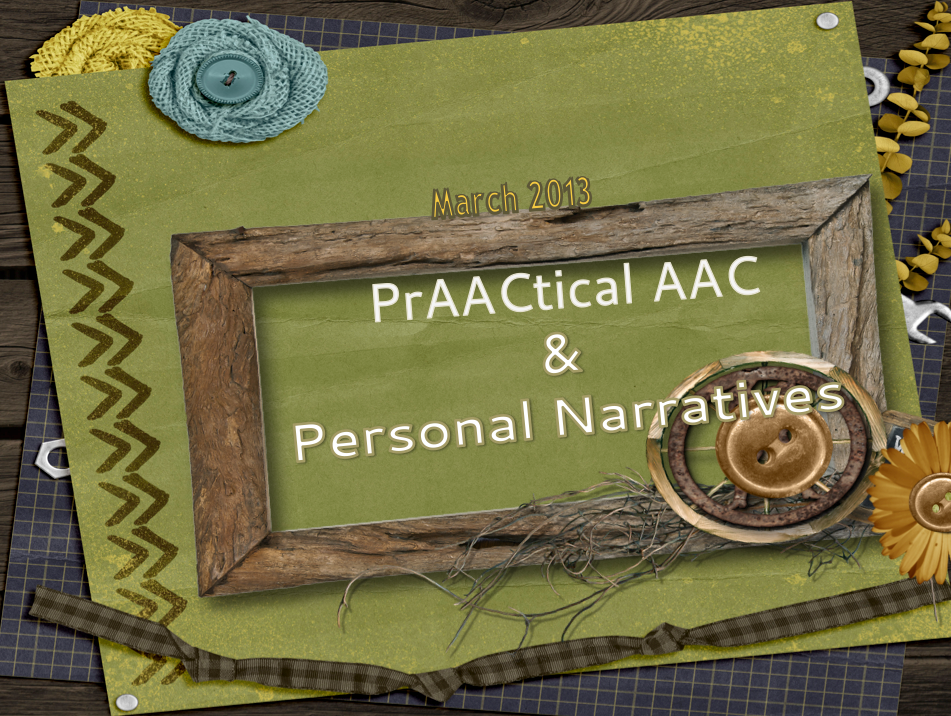
Personal narratives are the first story skills that develop. They tell about ourselves and our connection to activities, places, and events. They tell about how we feel about people and experiences. Personal narratives help us structure and organize the events of our lives and even become a way of thinking about ourselves and our identities. We know many AAC users have significant difficulty with narratives. We always wonder though, is it a function of language difficulty or of access, exposure, and PrAACtice or more likely a combination. There are key intervention strategies that help AAC learners be able to tell personal narratives. You probably won’t be surprised by what strategies work but the research from Gloria Soto and colleagues has shown us that when applied to personal narratives, AAC users can be competent story tellers. Some Thoughts on Personal Narrative Assessment Even before assessment of the AAC learner, in all fairness,... [Read More...]









